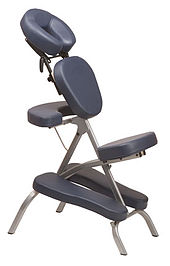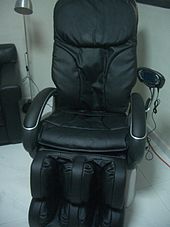- Massage chair
-
Massage chairs come in two main types.
Traditional massage chairs
Ergonomically designed chairs for positioning a person who will be receiving a massage, similar in function to a massage table. Chairs may be either stationary or portable models. Different chairs have different features, and many are adjustable to clients’ preferences and sizes. Massage therapists are able to offer on-site massage to many places of employment because of the portability of the massage chair.
Massage chairs are easier for the therapist to maneuver than massage tables, and clients do not need to disrobe to receive a chair massage. Due to these two factors, chair massage is often performed in settings such as corporate offices, outdoor festivals, shopping malls, and other public locations.
Robotic massage chairs
A robotic massage chair is a chair that contains internal electronic motors and gears designed to massage the person sitting in them. Most robotic massage chairs have some form of controller to vary the type, location, or intensity of massage.
Massaging chairs most frequently resemble recliners. There are many different types and brands, including office-style chairs that operate from internal batteries. A less expensive option is a separate massaging pad that may be used with an existing chair. Some of the available brands include Fujiiryoki, Family Inada, iRest, Masse, Omega, One Life, Kyokei, Masseuse, Back Doctor, Human Touch, Sanyo, Panasonic, SHSS, OSIM, OTO, VGO, OGAWA, Homedics, and Oregon Scientific.
Robotic massage chairs were first brought to market in 1962 by the Family Inada company. Today, Japan is the largest consumer of massage chairs with some surveys suggesting that over 20% of Japanese households actually own a massage chair. By comparison, massage chair penetration in the US market is estimated to be in the neighborhood of 1%. The current massage chair market is dominated at the top by a three dominant manufacturers: Fujiiryoki, Family Inada, and Panasonic. After the purchase of Sanyo by Panasonic, Panasonic announced plans to eliminate Sanyo as a brand for all current Sanyo consumer products.
The major US brand has been Human Touch, which fills the low-price to mid-market massage chair categories. Their most popular models are purported to be the sub-$1000 units of the line they call i-Joy. Human Touch grew rapidly in between 2003 and 2007 before their near-complete demise during the recession that followed 2007 - many industry insiders predicted that the company would fold. Their peak year was reportedly just over $127MM in sales. Their worst years in 2008 or 2009 were reportedly down by more than 50% from their peak.
Massaging chairs vary tremendously in price, style and intensity, from cheap "vibrate only" chairs to full intensity Shiatsu models for people who require as close to a real invigorating massage as possible.
References
Categories:- Chairs
- Massage
Wikimedia Foundation. 2010.


